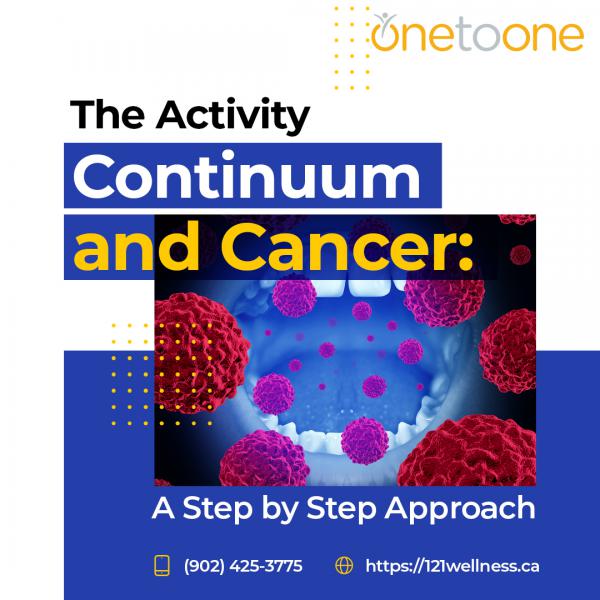
As an individual journey’s through their cancer diagnosis, the value of exercise cannot be overstated. It has benefits throughout all stages of treatment from pre-diagnosis for prevention, to all stages post diagnosis. It helps prepare your body and mind for treatments, recovery, pain management, coping skills and recurrence depending on what stage you are in (See Picture Below). 1,2
Another important health outcome post-cancer diagnosis is sedentary behaviour. This is concerning for the cancer population because 75% of their time is spent sedentary.1 Furthermore it has been shown that breast cancer survivors spend more time engaged in moderate to vigorous exercise, but spend more time sedentary than their healthy counterparts.,3 Additionally, engaging in this type of behaviour is being associated with cardiovascular risks, diabetes, and increased cancer risk. 4,5 So how do we reduce time spent not moving in a population that can struggle with pain, fatigue, and nausea just to name a few?7
First thing may be to start looking at activity as a continuum,1. When this is done, activity levels progress from doing nothing (.e.g., Watching TV) to activities such as sprinting. Both extremes are recommended occasionally, but not how we want to spend most of our day. In fact, the far right would be impossible to achieve. Now, depending on where an individual is at in their cancer recovery determines their starting point along the continuum. Some people may only be able to perform postural shifts to maintain comfort, and some may be able to do bouts of moderate exercise. Ideally, we want to spend most of our day in the middle of this continuum, with the goal of increasing the amount of time doing activities of daily living and light to moderate exercise.
From a rehabilitation standpoint, it would not be expected for someone to jump from sedentary to moderate exercise if they are physically and mentally unable to tolerate it. Understanding that discomfort and fatigue are two barriers to reducing sedentary behaviour in cancer populations6 is essential to this process. This makes us aware that we need to take more of a stepwise approach of building up tolerance by slowly pushing the limits of where your current level is to try and achieve the next activity goal (See Below). This is where professionals can help you gain a new perspective of why you are experiencing pain and fatigue, and give you strategies to better approach your activity transitions such as edgework and pacing. This may start with gentle postural shifts or mobility exercises to prep the musculature and nervous system to allow you to spend more time toward the middle of the continuum. It can also include multiple light walks or strengthening exercises, it all depends on your tolerance level.
Ultimately, the goal is to be as active as you possibly can throughout the day, and to understand that consistent movement within your limits has the potential to reduce various health risks. Although there is not a specific formula, what we know is that pain and cancer education, movement, exercise, and nutrition will put you in the best position to manage or overcome this cancer diagnosis, meanwhile reducing your future risk of side effects, recurrences, and other health issues.
“It is important to move and to move often, no matter how simple or limited the movement may be.1 ”1. Lucas AR, Klepin HD, Porges SW, Rejeski JW. Mindfulness-based movement: a polyvagal perspective. Int Can Ther. 2016. https://doi.org/10.1177/15347354166820872. Segal R, Zwaal C, Green E, Tomasone J, Loblaw A, Ptrella T, et al. Exercise for people with cancer. Toronto (ON): Cancer Care Ontario; 2015 Jun 30. Program in Evidence-based Care Guideline No.: 19-53. Phillips SM, Dodd KW, Steeves J, McClain J, Alfano CM, McAuley E. Physical activity and sedentary beavhiour in breast cancer survivors: new insight in to activity patterns and potential intervention targets. Gynecol Oncol.2015;138:398-4044. Wilmot EG, Edwardson CL, Achana FA, Davies MJ, Gorely T, Gray LJ, Khunti K, Yates T, Biddle SJH. Sedentary time in adults and the association with diabetes, cardiovascular disease and death: systematic review and meta-analysis. Diabet. 2012;55(11);2895-29055. Lynch BM. Sedentary behaviour and cancer: a systematic review of the literature and proposed biological mechanisms. Can Epid Bio Prev.2010. doi: 10.1158/1055-9965.EPI-10-08156. Courneya KS, McKenzie DC, Reid RD, Mackey JR, Gelmon K, Friedenreich CM, et al. Barriers to supervised exercise training in randomized controlled trial of breast cancer patients receiving chemotherapy. Ann Behav Med. 2008: 35;116-122.




